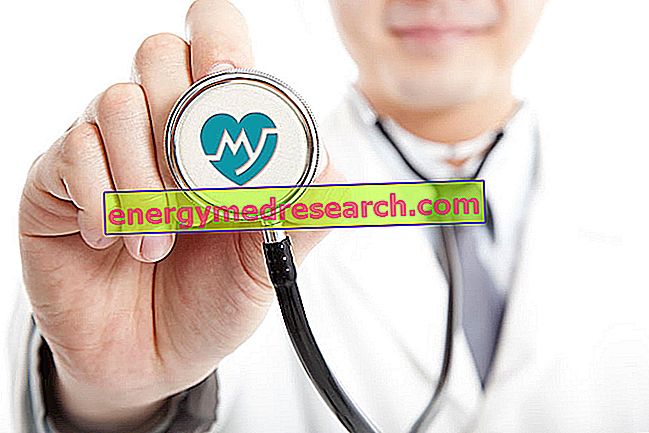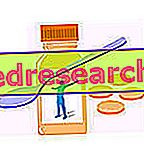Generality
High triglycerides is the terminology used in common jargon to indicate the medical condition more properly known as hypertriglyceridemia, or " high concentration of triglycerides in the blood ".
High triglycerides are often associated with factors such as: excessive alcohol consumption, food excesses (especially those characterized by the massive ingestion of simple sugars), the constant use of estrogen-progestins (including the contraceptive pill), diabetes not treated, hypothyroidism, cigarette smoking and severe kidney disease.

The treatment of hypertriglyceridemia is based on adequate causal therapy, the adoption of a lifestyle and a diet based on good health, and, if necessary, the intake of specific pharmacological preparations.
Brief review of triglyceridemia and triglycerides
Expressed in milligrams per deciliter (mg / dl), triglyceridemia indicates the concentration of triglycerides in the blood.
Transported in the plasma mainly by chylomicrons and VLDLs, and only in small part by LDL and HDL, triglycerides are a class of lipids that the human body synthesizes mainly starting from the fats ingested through the diet and which uses as a source of energy ( *).
Knowing the blood concentration of triglycerides is very important in the diagnostic field, since, together with the quantification of total cholesterol, LDL and HDL, it allows to establish the cardiovascular risk of an individual.
Too high concentrations of triglycerides are indicative of poor health and increased susceptibility to the development of diseases such as heart attacks, coronary heart disease, angina pectoris, atherosclerosis, stroke, etc.
In healthy people, triglyceridemia shows values between 50 and 150-200 mg / dl ; therefore, triglyceride concentrations lower or higher than this range are to be considered anomalous.
*: chylomicrons, VLDL, LDL and HDL are lipoproteins.
What are high triglycerides?
High triglycerides is the term that, in common jargon, indicates the medical condition known as hypertriglyceridemia, or high concentration of triglycerides in the blood.
In numbers, we talk about high triglycerides or hypertriglyceridemia whenever blood tests show triglyceride values above 200 mg / dl.
| Normal triglycerides | <150mg / dl |
Borderline triglycerides | 150-199mg / dl |
High triglycerides | 200-499mg / dl |
Very high triglycerides | > 500mg / dl |
Is it always a condition of danger?
As anticipated at the beginning of the article, high triglycerides are associated with greater susceptibility to diseases such as coronary heart disease, stroke, angina pectoris, myocardial infarction, atherosclerosis, etc .; in essence they are associated with increased cardiovascular risk.
This relationship is particularly valid, when hypertriglyceridemia is accompanied by other cardiovascular risk factors, such as the increase in LDL cholesterol (the so-called " bad cholesterol "), the reduction of HDL cholesterol (the so-called " good cholesterol ") and / the presence of diabetes .
Having said that, it is necessary to point out that the type of lipoprotein with which they are associated plays a decisive role in the dangerousness of high triglycerides. In fact, the chylomicron-triglyceride binomial appears to be devoid of atherogenic power (ie it does not cause atheromas, a typical consequence of atherosclerosis); atherogenic power that instead seems to also belong to the VLDL and is certainly proper of the LDL.
Curiosity: are high triglycerides more dangerous for men or women?
According to reliable scientific studies, in view of the increase in cardiovascular risk, high triglycerides would seem more dangerous for women.
High triglycerides and metabolic syndrome
High triglycerides are a typical marker - a diagnostic indicator - of the so-called metabolic syndrome .
The metabolic syndrome is that clinical condition, characterized by the simultaneous presence of at least three of the following cardiovascular risk factors:
- Hypertension;
- Hypertriglyceridemia;
- Hypercholesterolemia;
- Abdominal obesity;
- Fasting hyperglycemia.
Causes
The main causes and risk factors of high triglycerides are:
- A high calorie diet, rich in saturated fats and cholesterol, and / or rich in carbohydrates;
- Cigarette smoke;
- Excessive consumption of alcohol;
- Obesity, overweight and excessive sedentary life;
- The metabolic syndrome;
- Diabetes mellitus and a state of insulin resistance not adequately treated;
- Serious kidney diseases, such as kidney failure or nephrotic syndrome;
- Some endocrine diseases, such as hypothyroidism, Cushing's syndrome and acromegaly;
- Pancreatitis;
- Liver cirrhosis;
- The constant use of medicines such as estrogens, beta-blockers, thiazide diuretics, corticosteroids, birth control pills, protease inhibitors, retinoids, tamoxifen, etc .;
- The pregnancy;
- Genetic diseases, known as familial hypertriglyceridemia (or familial type IV hyperlipoproteinemia) and combined hyperlipidemia.
Curiosity: how widespread is family hypertriglyceridemia?
Belonging to the family hyperlipidemia group, familial hypertriglyceridemia is a very rare genetic disease, affecting only 1% of the general population
To learn more, read: Hypertriglyceridemia - Causes and Symptoms »
What is the biological mechanism that causes high triglycerides?
The aforementioned question is quite complex and a comprehensive answer requires profound knowledge of how food digestion works. Therefore, here, we will limit ourselves to explaining only for synthetic points from what originates the raising of triglyceridemia and the presence of high triglycerides.
- During meal digestion, intestinal cells capture dietary lipids and transform them into triglycerides; while performing this important operation, they also produce the aforementioned chylomicrons, whose job is to transport the newly formed triglycerides into the blood.
- Also during the digestion of meals, the liver also synthesizes triglycerides, but, unlike intestinal cells, it performs this action starting from dietary amino acids and glucose. After this synthesis operation, the liver unites the newly formed triglycerides with the already known VLDL, whose function is analogous to that covered by chylomicrons.
- Chylomicrons and VLDL transport triglycerides in the blood, in order to replenish the tissue cells of these lipids, which can be used as an immediate or reserve source of energy (accumulation in adipocytes).
- In normal conditions (balanced diet, absence of pathologies, etc.), the production of triglycerides and related transporters is in line with the needs of tissue cells. In other words, the supply of triglycerides adequately satisfies the demand for triglycerides, without waste.
Once chylomicrons and VLDL have released triglycerides to cells (they are so-called "discharged" or "impoverished"), they undergo a process of degradation and physiological disposal, because they are no longer useful.
- Contrary to what was described above, in pathological or abnormal conditions (eg: high-calorie diet with a high content of fats or sugars, diabetes, genetic abnormalities, etc.), the production of triglycerides and related transporters exceeds the demands of tissue cells or it does not satisfy them at all, due to the inability of tissue cells to introduce triglyceride transporters internally. All this leads to the accumulation of triglyceride transporters in the blood, hence to an increase in triglyceridemia.
Symptoms and complications
The presence of high triglycerides does not produce symptoms, except in the most serious cases; in fact, if the triglyceride values are particularly high (> 1, 000 mg / dl), there is a high probability that the patient will develop: severe abdominal pain, acute pancreatitis, xanthoma (degeneration of the skin, which takes on a yellowish color for the lipid accumulation), ocular anomalies ( retinal lipaemia ), hepatomegaly, splenomegaly and neurological symptoms .
It should be pointed out that, generally, behind a symptomatic condition of high triglycerides lies a genetic disease such as familial hypertriglyceridemia or combined family hyperlipidemia.
Complications of high triglycerides: summary
Briefly, in the presence of high triglycerides can follow:
- The appearance of a cardiovascular disease ;
- The development of atheromas at the vascular level ( atherosclerosis );
- Destruction of the pancreas, due to acute pancreatitis.
Diagnosis
To formulate a diagnosis of high triglycerides, a blood test is sufficient, made after a canonical sampling.
Generally, when measuring triglycerides in a blood sample, doctors also accompany the measurement of total cholesterol, HDL and LDL, as this is the only way to obtain a complete and reliable lipid profile of patients under observation.
Once the presence of high triglycerides has been established, the next step is to identify the causes, in order to plan the most appropriate therapy.
Preparation for blood test for triglyceride evaluation
For the blood test to evaluate triglycerides to be reliable, the patient must be fasting for at least 12 hours at the time of sampling and have consumed a light meal in the evening of the previous day.
Failure to observe this preparatory regulation may result in a false positive, ie a diagnosis of high triglycerides in people where the level of triglycerides is actually normal.
In the table below, the reader will be able to take note of other rules regarding how to adequately prepare for a blood test for triglyceride evaluation.
Other regulations preparatory to the blood test for the evaluation of triglycerides:
- If the patient is a moderate alcoholic consumer, avoid alcohol intake 2-3 days prior to withdrawal;
- Avoid overeating for at least 4-5 days before taking it;
- Do not exceed with physical activity in the 48 hours prior to collection.
Therapy
From the therapeutic point of view, the presence of high triglycerides requires adequate causal therapy (this clearly varies from patient to patient, depending on the causes of hypertriglyceridemia) and the adoption of a lifestyle and diet based on the banner of good health .
In the event that healthier lifestyles and diets are not very incisive or show that they need help, the treating physician may add a further treatment, this time of a pharmacological type.
Useful drugs against high triglycerides include: fibrates, niacin, fish oil (an essential fatty acid supplement) and statins.
Key points of treatment of high triglycerides
- Improve lifestyle by reaching and maintaining a healthy weight, decreasing the consumption of carbohydrates and alcohol, increasing physical activity, not smoking and preferring healthy foods (foods rich in omega-3, whole grains, legumes, lean meats, fruit, vegetables etc.);
- Correct the specific cause of hypertriglyceridemia;
- If the problem persists, undergo the drug therapies provided for in these circumstances, which may include the use of: fibrates, essential fatty acid supplements, niacin and / or statins.
Causal therapy: some examples
- First example. If high triglycerides are due to the constant use of a certain medicine, the causal therapy is to stop taking this medicine immediately.
- Second example. If the cause of hypertriglyceridemia is specifically the excessive consumption of alcohol, the causal therapy consists in avoiding categorically the intake of alcoholic beverages.
- Third example. If high triglycerides depend on kidney disease, the causal therapy involves a treatment aimed at counteracting the kidney dysfunction present, although the latter is treatable.
- Fourth example. If there is specifically a state of obesity behind hypertriglyceridemia, causal therapy consists of a dietary plan aimed at reducing body weight and an educational plan aimed at teaching the patient the rules underlying a healthy and balanced diet.
Lifestyle and diet: how should they be?
Regardless of the triggering causes, in the presence of high triglycerides it is always very important:
- Keep body weight under control, with a balanced diet and the right physical activity, to avoid overweight or obesity and a sedentary lifestyle;
- Reduce or, better yet, avoid alcohol;
- Reduce the consumption of simple sugars (sweets, dehydrated fruit and sugary fruits, such as figs, bananas, grapes, mandarins and persimmons);
- Limit calorie intake, but above all avoid binge eating;
- Eat fish at least 2-3 times a week. Particularly suitable are fish with a high omega-3 content, such as salmon, sardine, mackerel, trout or herring;
- Prefer legumes to meat, especially fatty meats;
- Not smoking;
- Limit the consumption of foods rich in saturated fats (eg: dairy products and fatty meat), replacing them with foods rich in monounsaturated fatty acids and, in particular, oleic acid (olive oil, dried fruit and vegetable oils in general);
- Reduce or, better yet, avoid the consumption of hydrogenated fats, contained above all in snacks, snacks and packaged bakery products;
- Eat antioxidant-rich foods daily (so more fruit, vegetables, etc.);
- Prefer the consumption of whole grains to the consumption of refined cereals;
- Limit the use of salt to flavor food.
To learn more, read: Diet for high triglycerides - Example Diet for high triglycerides »
Drugs for hypertriglyceridemia
- Fibrates : derivatives of fibric acid, they represent the most effective drugs in the presence of hypertriglyceridemia;
- Niacin : in addition to reducing triglyceridemia, it is also able to lower cholesterol and raise HDL levels ("good cholesterol");
- Fish oil : source of omega-3 fatty acids, in addition to having hypotriglyceridemizing properties, it also has hypoglycemic, cardioprotective, antioxidant, anti-inflammatory, etc .;
- Statins : although their main indication is to reduce LDL cholesterol, they are also sufficiently effective against hypertriglyceridemia.
In the presence of high triglycerides and high LDL cholesterol, they represent an ideal pharmacological solution.
Their association with fibrates requires caution, because it could be harmful to the muscles.
To learn more, read: drugs against high triglycerides »
Curiosity
In addition to the aforementioned situations, the use of drugs against high triglycerides can be indispensable even in all those situations where, after appropriate medical evaluation, there is the real danger of hypertriglyceridemia damage to the pancreas.
To learn more: Effective Remedies for Lowering Triglycerides »
Prognosis
With the appropriate causal therapy and the adoption of a healthy lifestyle and diet, the hopes of reducing high triglycerides and bringing triglyceridemia back to normal are considerable.
However, we must not forget that:
- Given the same causal conditions, some individuals respond better than others to the same treatments. So each patient represents a case in itself;
- There are fewer treatable causes of high triglycerides than others, and this clearly affects the possibility of treating hypertriglyceridemia more effectively.
Prevention
Not smoking, adopting a balanced diet based on healthy foods, practicing physical activity regularly, not abusing alcoholic beverages and periodically controlling blood glucose are the main recommendations of doctors, when the topic of discussion is the prevention of high triglycerides.



